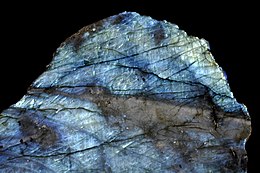| Labradorite | |
|---|---|
 Labradorite in a polished rock slab | |
| General | |
| Category | Adularescence, tectosilicate |
| Formula (repeating unit) | (Ca,Na)(Al,Si)4O8, where Na is 30-50% & Ca is 50–70% |
| Crystal system | Triclinic |
| Crystal class | Pinacoidal (1) (same H-M symbol) |
| Unit cell | a = 8.155 Å, b = 12.84 Å c = 10.16 Å; α = 93.5° β = 116.25°, γ = 89.133°; Z = 6 |
| Identification | |
| Color | Gray, gray-white, brown, greenish, pale green, blue, orange, pink, yellow, colorless |
| Crystal habit | Crystals typically thin and tabular, rhombic in cross section, striated; massive |
| Twinning | Common by albite, pericline, Carlsbad, Baveno, or Manebach twin laws |
| Cleavage | Perfect on {001}, less perfect on {010}, intersecting at near 90°; distinct on {110} |
| Fracture | Uneven to conchoidal |
| Mohs scale hardness | 6–6.5 |
| Luster | Vitreous to pearly on cleavages |
| Streak | White |
| Diaphaneity | Translucent to transparent |
| Specific gravity | 2.68 to 2.72 |
| Optical properties | Biaxial (+) |
| Refractive index | nα = 1.554–1.563 nβ = 1.559–1.568 nγ = 1.562–1.573 |
| Birefringence | δ = 0.008–0.010 |
| 2V angle | Measured: 85° |
| Dispersion | None |
| Other characteristics | Labradorescence (iridescence, schiller optical effect) |
| References | [1][2][3] |
Labradorite ((Ca, Na)(Al, Si)4O8) is a calcium-enriched feldspar mineral first identified in Labrador, Canada, which can display an iridescent effect (schiller).
Labradorite is an intermediate to calcic member of the plagioclase series. It has an anorthite percentage (%An) of between 50 and 70. The specific gravity ranges from 2.68 to 2.72. The streak is white, like most silicates. The refractive index ranges from 1.559 to 1.573 and twinning is common. As with all plagioclase members, the crystal system is triclinic, and three directions of cleavage are present, two of which are nearly at right angles and are more obvious, being of good to perfect quality (while the third direction is poor). It occurs as clear, white to gray, blocky to lath shaped grains in common mafic igneous rocks such as basalt and gabbro, as well as in anorthosites.